2004印度洋海啸英语介绍
- 格式:pptx
- 大小:1.07 MB
- 文档页数:7


13.3 The Indian Ocean TsunamiThe Indian Ocean tsunami, which took place in late 2004, shocked and grieved the whole world. It swept many Indian Ocean countries like Indonesia, Thailand and Sri Lanka. The death toll reached 300,000 of whom 100,000 were Indonesians. Lots of families lost their loved ones. During this unexpected disaster, the number of people who suffered directly or indirectly reached 5 million. The international community has given disaster relief aid and donations to the disaster-stricken areas. The aid from the Chinese government and people was over 1.2 billion RMB. Such a great disaster in the 21st century deserves pondering. Reflecting upon the disaster, people ask why it happened and whether it could have been avoided. People now are revealing in-depth thought and analysis on the cause of the disaster.First, it was a punishment for humanity’s behavior against nature. The primary cause of the catastrophe lay in the great number of houses built along the ocean shores and the great damage done to the environment. Earthquakes and their resulting tsunamis are natural phenomena. However, this tsunami claimed tens of thousands of lives. We cannot wholly attribute it to nature because human beings have expropriated places that should not be expropriated. Numerous hotels and restaurants were built along the seafront in many countries in order to attract tourists. This has undoubtedly increased the risk of being struck by natural disasters. Some experts have pointed out that coral reefs and mangroves in the shallow water areas could have protected people from the tsunami. However, in the past 20 or 30 years, people have fished and farmed shrimp and logged mangroves in excess. As a result, people have paid a heavy price.Secondly, the lack of preventive and warning mechanisms against tsunami left people completely unprepared and unprotected. The earthquake itself didn’t cause the huge damage, but the tsunami that followed it 2 hours afterwards when many areas had already felt the quake. Had there been an effective preventive and warning mechanism, the local people would have had enough time to get clear. The death toll and other losses would have been minimized.After the disaster, some state leaders gave speeches urging the international community to take preventive measures and to minimize the losses caused by natural disasters like the tsunami. People should learn lessons from it and take on the responsibility to protect the global environment. The governments of the countries concerned should work together to establish a preventive and warning mechanism. The international community should also learn lessons from the Indian Ocean tsunami and find out what still needs to be done, and raise people’s awareness of how to survive earthquakes and tsunamis. Though we cannot avoid similar disasters, we can certainly minimize the losses through our concerted efforts.。


Tsunami>Tsunami Essay:The term Tsunami comes from the Japanese language and means harbour wave. Tsunamis are seismic waves that are caused by earthquakes which travel through water. An earthquake that is too small to create a tsunami by itself may trigger an undersea landslide quite capable of generating a tsunami.Long and Short Essays on Tsunami for Kids and Students in EnglishGiven below are two essays in English for students and children about the topic of ‘Tsunami’ in both long and short form. The first essay is a long essay on Tsunami of 400-500 words. This long essay about Tsunami is suitable for students of class 7, 8, 9 and 10, and also for competitive exam aspirants. The second essay is a short essay on Tsunami of 150-200 words. These are suitable for students and children in class 6 and below.Long Essay on Tsunami 500 Words in EnglishBelow we have given a long essay on Tsunami of 500 words is helpful for classes 7, 8, 9 and 10and Competitive Exam Aspirants. This long essay on the topic is suitable for students of class 7 to class 10, and also for competitive exam aspirants.Tsunami can be generated when the sea floor abruptly deforms and vertically displaces the overlying water. Such large vertical movements of the earth’s crust can occur at plate boundaries. Alt hough often referred to as ‘tidal waves’, a tsunami does not look like the popular impression of ‘a normal wave only much bigger’. Instead, it looks rather like an endlessly onrushing tide which forces its way around andthrough any obstacle. Most of the damage is caused by the huge mass of water behind the initial wave front, as the height of the sea keeps rising fast and floods powerfully into the coastal areas. The sheer weight of water is enough to pulverise objects in its path, often reducing buildings to their foundations and scouring exposed ground to the bedrock. Large objects such as ships and boulders can be carried several miles inland before, a Tsunami subsides.It is said that the Greek historian Thucydides proposed that Tsunamis had some relation to submarine earthquakes. However, theunderstanding of Tsunami’s nature and causes remained weak until the 20th century. Roman historian, Ammianus described the order of events giving rise to a Tsunami: an earthquake, sudden retreat of the sea followed by a gigantic wave. Japan has the longest recorded history of Tsunamis. The 2004 Indian Ocean earthquake cum Tsunami is marked as one of the most devastating in modern times, taking the death toll to around 2,30,000 people. The Sumatran region also experiences earthquakes off the coast regularly.Recently, it has been discovered that larger Tsunamis than previously believed possible could be caused by landslides, explosive volcanic actions and Earth-scouring impact events. These phenomena rapidly displace large volumes of water, as energy from falling debris or expansion is transferred to the water into which the debris fall. Tsunamis caused by these mechanisms, unlike the ocean-wide tsunamis caused by some earthquakes, generally dissipate quickly and rarely affect coastlines distant from the source due to the small area of the sea affected.Tsunamis move the entire depth of the ocean (often several kilometres deep) rather than just the surface, so they contain immense energy, propagate at high speeds and can travel great trans-oceanic distances with little overall energy loss. A Tsunami can cause damage thousands of kilometres from its origin, so there may be several hours between its creation and its impact on a coast, arriving long after the seismic wave generated by the originating event arrives.In open water, Tsunamis have extremely long periods from minutes to hours, and long wavelengths of up to several hundred kilometres.This is very different from typical wind-generated swells on the ocean, which might have a period of about 10 seconds and a wavelength of 150 metres.A few signs may be triggered by nature to warn a huge tsunami wave. An earthquake may be felt. Large quantities of gas may bubble to the water surface and make the sea look as if it is boiling. The water in the waves may be unusually hot. The water may sometimes smell of rotten eggs due to the presence of hydrogen sulphide or of petrol or oil. The water may sting the skin.A thunderous boom may be heard followed by a roaring noise as of a jet plane, a helicopter, or a whistling sound. The sea may recede to a considerable distance.A flash of red light might be seen near the horizon and as the wave approaches, the top of the wave may glow red. These signals have been recorded from time to time over the ages before every Tsunami tragedy. Oceanographers, scientists, geologists and environmentalists are working on making some kind of systems which can if not prevent atleast signal the impending Tsunami.The Lisbon quake is the first documented case of such a phenomenon in Europe back in 1 755 which had generated an almost 12 metre high sea wave and had destroyed most part of the city killing around 60000 people. This phenomenon was also seen in Sri Lanka in the 2004 Indian Ocean earthquake. In 2011, the powerful 8.9 magnitude earthquake sent Japan into chaos as it triggered a giant tsunami in the Pacific Ocean, sweeping away boats, cars, homes and people, and led to the loss of more than 15000 lives in Japan.In some particularly Tsunami-prone countries, measures have been taken to reduce the damage caused on the shores. Japan has implemented an extensive programme of building Tsunami walls of up to 4.5m (13.5 ft) high in front of populated coastal areas. Other localities have built floodgates and channels to redirect the water from incoming tsunamis. However, their effectiveness has been questioned, as Tsunamis are often higher than the barriers.For instance, the Tsunami which hit the island of Hokkaido on 12 July, 1993 created waves asmuch as 30 m (100 ft) tall –as high as a 10-storey building. The port town of Aonae was completely surrounded by a Tsunami wall but the waves washed right over the wall and destroyed all the wood-framed structures in the area.The wall may have succeeded in slowing down and moderating the height of the Tsunami but it did not prevent major destruction and loss of life.Yet the effects of a Tsunami can be mitigated by natural factors such as tree cover on the shoreline. Some locations in the path of the 2004 Indian Ocean Tsunami escaped almostunscathed as a result of the tsunami’s energy being sapped by a belt of trees such as coconut, palms and mangroves. In one striking example, the village of Naluvedapathy in India’s Tamil Nadu region suffered minimal damages and few deaths as the wave broke up on a forest of 80244 trees planted along the stretches of seacoasts that are prone to Tsunami risks.While it would take some years for the trees to grow to a useful size, such plantations could offer a much cheaper and longer-lasting means of Tsunami mitigation than the costly andenvironmentally destructive method of erecting artificial barriers.Short Essay on Tsunami 200 Words in EnglishBelow we have given a short essay on Tsunami is for Classes 1, 2, 3, 4, 5 and 6. This short essay on the topic is suitable for students of class 6 and below.Regions with a high risk of Tsunamis may use Tsunami warning systems now available to detect Tsunamis and warn the general populace before the waves reach the coasts. In some communities on the West coast of the UnitedStates, which is prone to Pacific Ocean Tsunamis, warning signs advise people where to run in the event of an incoming Tsunami. Computer models can roughly predict Tsunami arrival and impact based on information about the event that triggered it and the shape of the sea floor and the coastal landmass. One of the early warnings comes from nearby animals. Many animals sense danger and flee to higher ground before the water arrives. Monitoring their behaviour closely could provide advance warnings of earthquakes, Tsunamis etc.In 2011, Earthquake Research Committee of Japanese Government announced that Tsunami forecasts would be started to alert the public in advance about the approaching Tsunamis in near future. This would comprise Tsunamic height, attack area and probability of occurrence within 100 years. Such forecasts should be soon activated in the Indian sub-continent also. The Intergovernmental Oceanographic Commission, UNESCO is working out strategies for this area.Coastal areas of India are sitting on a ‘Tsunami-bomb’. Awareness and robust measures are the needs of the hour.Tsunami Essay Word Meanings for Simple UnderstandingSeismic –pertaining to, of the nature of, or caused by an earthquake or vibration of the earth, Whether due to natural or artificial causesPulverise – to demolish or crush completelyScouring – to clear or dig out (a channel, drain, etc) as by the force of water, by removing debris, etcWavelength –the distance, measured in the direction of propagation of a wave, between twosuccessive points in the wave that are characterised by the same phase of oscillationRecede – to go or move away, withdrawOceanographer –the branch of physical geography dealing with the oceanUnscathed – not scathed, unharmed, uninjuredDissipate – to use up or waste, to disperse。

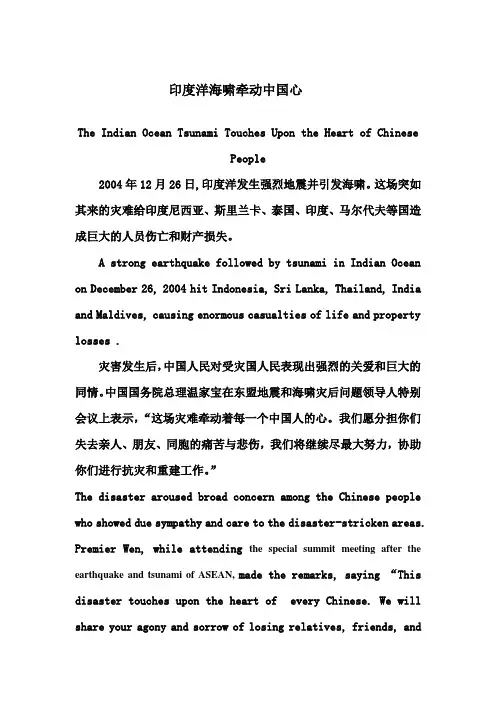
印度洋海啸牵动中国心The Indian Ocean Tsunami Touches Upon the Heart of ChinesePeople2004年12月26日,印度洋发生强烈地震并引发海啸。
这场突如其来的灾难给印度尼西亚、斯里兰卡、泰国、印度、马尔代夫等国造成巨大的人员伤亡和财产损失。
A strong earthquake followed by tsunami in Indian Ocean on December 26, 2004 hit Indonesia, Sri Lanka, Thailand, India and Maldives, causing enormous casualties of life and property losses .灾害发生后,中国人民对受灾国人民表现出强烈的关爱和巨大的同情。
中国国务院总理温家宝在东盟地震和海啸灾后问题领导人特别会议上表示,“这场灾难牵动着每一个中国人的心。
我们愿分担你们失去亲人、朋友、同胞的痛苦与悲伤,我们将继续尽最大努力,协助你们进行抗灾和重建工作。
”The disaster aroused broad concern among the Chinese people who showed due sympathy and care to the disaster-stricken areas. Premier Wen, while attending the special summit meeting after the earthquake and tsunami of ASEAN, made the remarks, saying “This disaster touches upon the heart of every Chinese. We will share your agony and sorrow of losing relatives, friends, andcompatriots. We will do our best to assist your fighting the calamity and reconstruction.”中国政府进行了迄今为止最大规模的对外救援行动,向受灾国增拨援助资金,并很快派出数批医疗队和救援队,迅速赶赴灾区现场参加救援工作,各种救灾物资紧急运抵主要受灾国家。
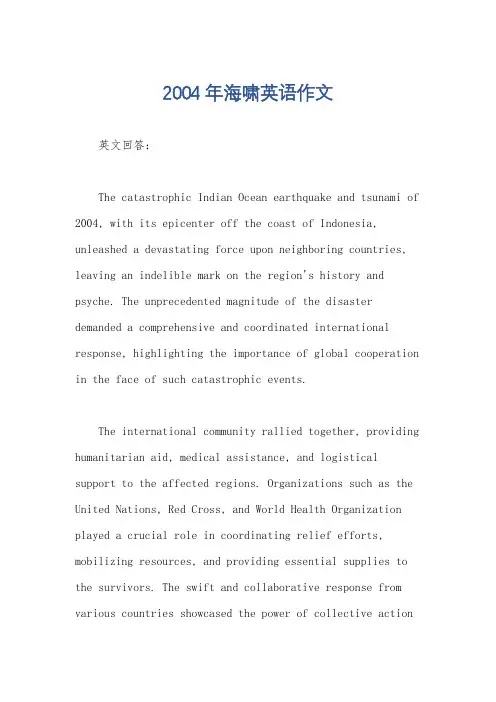
2004年海啸英语作文英文回答:The catastrophic Indian Ocean earthquake and tsunami of 2004, with its epicenter off the coast of Indonesia, unleashed a devastating force upon neighboring countries, leaving an indelible mark on the region's history and psyche. The unprecedented magnitude of the disaster demanded a comprehensive and coordinated international response, highlighting the importance of global cooperation in the face of such catastrophic events.The international community rallied together, providing humanitarian aid, medical assistance, and logistical support to the affected regions. Organizations such as the United Nations, Red Cross, and World Health Organization played a crucial role in coordinating relief efforts, mobilizing resources, and providing essential supplies to the survivors. The swift and collaborative response from various countries showcased the power of collective actionin times of extreme crisis.However, the 2004 tsunami also exposed vulnerabilities in the region's disaster preparedness and response systems. The lack of early warning systems, inadequate infrastructure, and limited awareness of tsunami risks resulted in a staggering loss of life. It became evident that investing in robust disaster preparedness measures was paramount to mitigating the impact of future disasters.In the aftermath of the tragedy, coastal communities and governments around the Indian Ocean region implemented various measures to enhance their resilience and preparedness. These included the establishment of early warning systems, community-based disaster preparedness plans, and the dissemination of public education campaigns. The Indian Ocean Tsunami Warning System (IOTWS), a sophisticated network of sensors and data centers, was established to provide real-time alerts and warnings to at-risk areas.The 2004 tsunami served as a stark reminder of thedevastating potential of natural disasters and the urgent need for international cooperation and comprehensive disaster preparedness measures. The lessons learned from this tragedy have contributed to advancements in early warning systems, disaster risk reduction strategies, and community resilience. By investing in these measures, we can better protect lives and livelihoods from future disasters and create a more resilient world.中文回答:2004年印度洋地震和海啸是一场毁灭性的灾难,震中位于印度尼西亚海岸附近,对邻国造成了毁灭性的打击,在该地区的歷史和心理上留下了不可磨灭的印记。
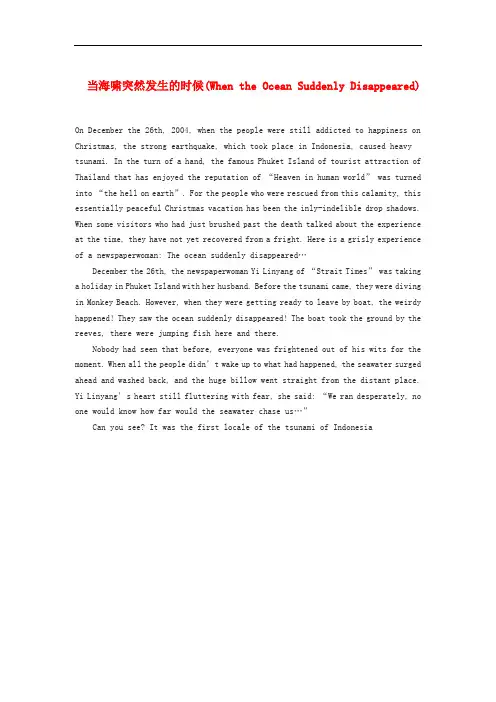
当海啸突然发生的时候(When the Ocean Suddenly Disappeared)On December the 26th, 2004, when the people were still addicted to happiness on Christmas, the strong earthquake, which took place in Indonesia, caused heavy tsunami. In the turn of a hand, the famous Phuket Island of tourist attraction of Thailand that has enjoyed the reputation of “Heaven in human world” was turned into “the hell on earth”. For the people who were rescued from this calamity, this essentially peaceful Christmas vacation has been the inly-indelible drop shadows. When some visitors who had just brushed past the death talked about the experience at the time, they have not yet recovered from a fright. Here is a grisly experience of a newspaperwoman: The ocean suddenly disappeared…December the 26th, the newspaperwoman Yi Linyang of “Strait Times” was taking a holiday in Phuket Island with her husband. Before the tsunami came, they were diving in Monkey Beach. However, when they were getting ready to leave by boat, the weirdy happened! They saw the ocean suddenly disappeared! The boat took the ground by the reeves, there were jumping fish here and there.Nobody had seen that before, everyone was frightened out of his wits for the moment. When all the people didn’t wake up to what had happened, the seawater surged ahead and washed back, and the huge billow went straight from the distant place. Yi Linyang’s heart still fluttering with fear, she said: “We ran desperately, no one would know how far would the seawater chase us…”Can you see? It was the first locale of the tsunami of Indonesia。
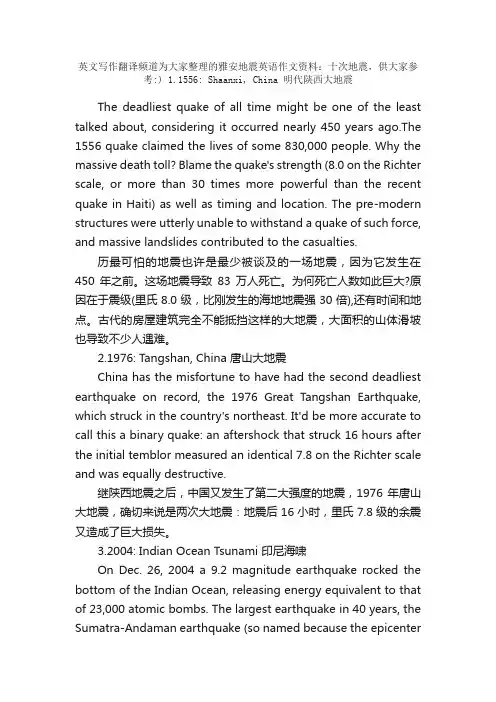
英文写作翻译频道为大家整理的雅安地震英语作文资料:十次地震,供大家参考:) 1.1556: Shaanxi, China 明代陕西大地震The deadliest quake of all time might be one of the least talked about, considering it occurred nearly 450 years ago.The 1556 quake claimed the lives of some 830,000 people. Why the massive death toll? Blame the quake's strength (8.0 on the Richter scale, or more than 30 times more powerful than the recent quake in Haiti) as well as timing and location. The pre-modern structures were utterly unable to withstand a quake of such force, and massive landslides contributed to the casualties.历最可怕的地震也许是最少被谈及的一场地震,因为它发生在450年之前。
这场地震导致83万人死亡。
为何死亡人数如此巨大?原因在于震级(里氏8.0级,比刚发生的海地地震强30倍),还有时间和地点。
古代的房屋建筑完全不能抵挡这样的大地震,大面积的山体滑坡也导致不少人遇难。
2.1976: Tangshan, China 唐山大地震China has the misfortune to have had the second deadliest earthquake on record, the 1976 Great Tangshan Earthquake, which struck in the country's northeast. It'd be more accurate to call this a binary quake: an aftershock that struck 16 hours after the initial temblor measured an identical 7.8 on the Richter scale and was equally destructive.继陕西地震之后,中国又发生了第二大强度的地震,1976年唐山大地震,确切来说是两次大地震:地震后16小时,里氏7.8级的余震又造成了巨大损失。
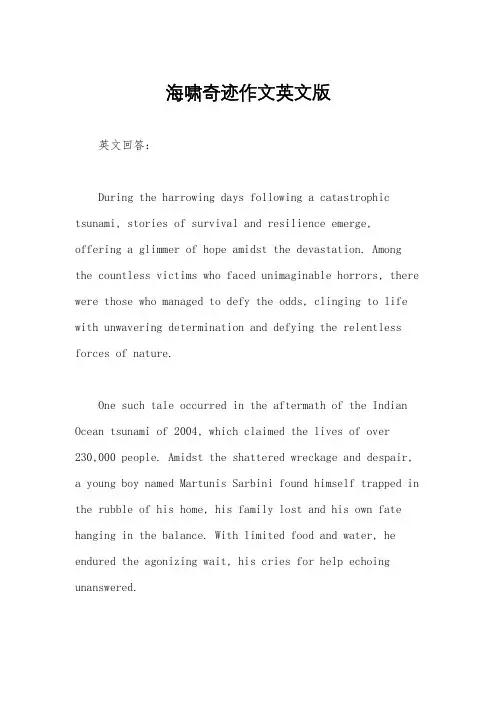
海啸奇迹作文英文版英文回答:During the harrowing days following a catastrophic tsunami, stories of survival and resilience emerge,offering a glimmer of hope amidst the devastation. Among the countless victims who faced unimaginable horrors, there were those who managed to defy the odds, clinging to life with unwavering determination and defying the relentless forces of nature.One such tale occurred in the aftermath of the Indian Ocean tsunami of 2004, which claimed the lives of over 230,000 people. Amidst the shattered wreckage and despair, a young boy named Martunis Sarbini found himself trapped in the rubble of his home, his family lost and his own fate hanging in the balance. With limited food and water, he endured the agonizing wait, his cries for help echoing unanswered.As days turned into an eternity, Martunis's hope began to dwindle. Yet, deep within him, a flicker of survival instinct remained alight. He summoned all his remaining strength, using a piece of metal to chisel away at the debris that imprisoned him. Inch by inch, he clawed his way towards freedom, driven by an indomitable determination to live.Unbeknownst to Martunis, a group of Indonesian soldiers was searching for survivors amidst the devastation. Guided by faint noises, they stumbled upon a dilapidated house and cautiously approached. To their astonishment, they heard a faint scratching sound coming from within the ruins. With renewed vigor, they began to dig, their hearts pounding with anticipation.Finally, after hours of relentless effort, the soldiers reached Martunis, who was weak and emaciated but stillalive against all odds. Tears of joy and relief streamed down their faces as they carefully extracted him from the wreckage. Martunis had endured 21 grueling days trapped in the darkness, his spirit unbroken and his hope unwavering.The story of Martunis Sarbini became a symbol of resilience and perseverance in the face of adversity. It reminded the world that even in the darkest of times, the human spirit has the capacity to triumph over tragedy. His tale serves as a testament to the indomitable power of hope and the unyielding nature of the human soul.中文回答:在海啸过后的悲惨日子里,关于生存和韧性的故事开始出现,给这场灾难带来了希望的曙光。
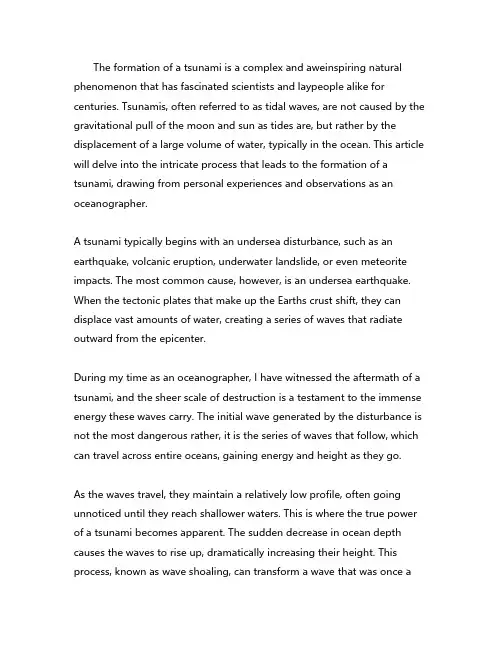
The formation of a tsunami is a complex and aweinspiring natural phenomenon that has fascinated scientists and laypeople alike for centuries.Tsunamis,often referred to as tidal waves,are not caused by the gravitational pull of the moon and sun as tides are,but rather by the displacement of a large volume of water,typically in the ocean.This article will delve into the intricate process that leads to the formation of a tsunami,drawing from personal experiences and observations as an oceanographer.A tsunami typically begins with an undersea disturbance,such as an earthquake,volcanic eruption,underwater landslide,or even meteorite impacts.The most common cause,however,is an undersea earthquake. When the tectonic plates that make up the Earths crust shift,they can displace vast amounts of water,creating a series of waves that radiate outward from the epicenter.During my time as an oceanographer,I have witnessed the aftermath of a tsunami,and the sheer scale of destruction is a testament to the immense energy these waves carry.The initial wave generated by the disturbance is not the most dangerous rather,it is the series of waves that follow,which can travel across entire oceans,gaining energy and height as they go.As the waves travel,they maintain a relatively low profile,often going unnoticed until they reach shallower waters.This is where the true power of a tsunami becomes apparent.The sudden decrease in ocean depth causes the waves to rise up,dramatically increasing their height.This process,known as wave shoaling,can transform a wave that was once afew meters high into a towering wall of water.The speed at which a tsunami travels is also remarkable.Tsunamis can travel at speeds of up to500miles per hour in the deep ocean,covering vast distances in a relatively short amount of time.This rapid movement makes it difficult to provide adequate warning to coastal communities, increasing the potential for widespread devastation.Upon reaching the shore,the impact of a tsunami is nothing short of catastrophic.The immense force of the waves can wash away entire towns, destroy infrastructure,and cause significant loss of life.The2004Indian Ocean tsunami is a stark example of this,with over230,000people losing their lives in14different countries.In addition to the immediate destruction,tsunamis can also cause longterm environmental damage.The powerful waves can reshape coastlines,erode beaches,and disrupt ecosystems.The2011Tohoku tsunami in Japan,for instance,not only caused widespread devastation but also led to the release of radioactive water from the Fukushima nuclear power plant,highlighting the potential for longlasting environmental consequences.Despite the immense power of tsunamis,there are measures that can be taken to mitigate their impact.Early warning systems,such as the DeepOcean Assessment and Reporting of Tsunamis DART,can detect tsunamis in the deep ocean and provide valuable time for coastal communities to prepare.Additionally,the construction of seawalls andother protective infrastructure can help to reduce the damage caused by these powerful waves.In conclusion,the formation of a tsunami is a fascinating and powerful process that underscores the immense forces at work within our planet. While the destruction caused by tsunamis can be devastating, understanding the processes that lead to their formation and implementing effective warning and protective measures can help to minimize their impact.As an oceanographer,witnessing the power of a tsunami firsthand has been both humbling and enlightening,serving as a reminder of the aweinspiring forces that shape our world.。
《海啸奇迹》英文阅读《海啸奇迹》英文阅读Ang Lee, and "Life of Pi" 3D in the central section, is amazing, well worth a visit just for itself. It's in cinema's certificate PG. And we're at sea again but in a horrifying rather than dazzling way for "The Impossible", a film based on the experience of a Spanish family on holiday in Thailand, caught up in the massive tidal wave and aftershocks of the Indian Ocean tsunami of 2004. The film is a Spanish production and it's prompted the biggest opening weekend box office take in the country's history. Yet on screen, the family speak English, and appear to be British, with the mother played by Naomi Watts and the father by Ewan McGregor. When the disaster strikes, the mother and one of the sons are swept inland. In the hours and days that follow, the father and the other two boys search for them, sometimes teaming up with other tourists also looking for friends and relatives. At night, they all share stories. Ewan McGregor and Snke Mhring? in "The Impossible". The film's Spanish director Juan Antonio Bayona is best known for a horror film "The Orphanage", and "The Impossible" is certainly terrifying a perfectly realistic evocation of the disaster itself. But we know it must have been terrible. So what is the point of recreating the experience? Ewan McGregor.I was told about that I was being sent a script about the tsunami and my first impressions were so mixed about whether that was a good idea or is that right? Is it right to make a film about something a disaster like this that happened when so many people lost their lives and I think those are good concerns to have. So as I read it and there suppose those were at the back of my mind, but I was totally convinced by the end that the scriptwas a valid one. The story somehow by focusing on just one family's experience in something terrible like this.。
当海啸突然发生的时候(When the Ocean Suddenly Disappeared)On December the 26th, 2004, when the people were still addicted to happiness on Christmas, the strong earthquake, which took place in Indonesia, caused heavy tsunami. In the turn of a hand, the famous Phuke t Island of tourist attraction of Thailand that has enjoyed the reputation of “Heaven in human world” was turned into “the hell on earth”. For the people who were rescued from this calamity, this essentially peaceful Christmas vacation h as been the inly-indelible drop shadows. When some visitors who had jus t brushed past the death talked about the experience at the time, they have not yet recovered from a fright. Here is a grisly experience of a newspaperwoman: The ocean s uddenly disappeared…December the 26th,the newspaperwoman Yi Linyang of “Strait Times” was taking a holiday in Phuket Island with her husband. Before the tsunami came, they were diving in Monkey Beach. However, when they were getting ready to leave by boat, the weirdy happened! They saw the ocean sud denly disappeared! The boat took the ground by the reeves, there were jumping fish here and there.Nobody had seen that before, everyone was frightened out of his wits for the moment. When all the people didn’t wake up to what had happened, the seawater surged ahead and washed back, and the huge billow went straight from the distant place. Yi Linyang’s heart still fluttering with fear, she said: “We ran desperately, no one wou ld know how far would the seawater chase us…”Can you see? It was the first locale of the tsunami of Indonesia。
北印度洋苏门答腊和莫克兰俯冲带地震海啸综述赵旭;徐敏;曾信;林间【期刊名称】《热带海洋学报》【年(卷),期】2017(036)006【摘要】The frequency of tsunamis occurred in the Indian Ocean is much lower than that of the Pacific Ocean; in the past fifteen years, however, three out of ten major tsunamis triggered by the earthquake occurred in the Indian Ocean region. The Makran and the Sumatra subduction zones are the two active regions in the North Indian Ocean for tsunamigenic earthquakes. In the northern Sumatra subduction zone, two earthquakes with Mw 9.0 and 8.6 occurred on December 26, 2004 and March 28, 2005, respectively, and they were ranked as the second and fourth largest earthquakes in the past half century. The 2004 event generated a tsunami disaster with the largest wave runup of 50.9m, and resulted in the most devastating historical disaster, while the 2005 event only generated a maximum wave runup of 4m. What caused the completely different tsunami scenarios by the two earthquakes with similar location and focal mechanism is worthy of study. Recent studies showed that the seismic activities along the Makran subduction zone were divided into two neighboring sections: the seismic activity of the eastern section is significantly stronger than the western section, and the 1945 tsunami was located in this section. Whether the western section, or the whole Makransubduction zone has the potential to rupture together and thus generate major tsunamis requires further investigations.%印度洋海啸发生的频率远低于太平洋,但2000年以来全球因地震引发的10个重大海啸有3个发生在印度洋区域.苏门答腊和莫克兰俯冲带是北印度洋中地震海啸活动较活跃的两个区域.在苏门答腊俯冲带北端,2004年12月26日和2005年3月28日分别发生了里氏9.0级和8.6级大地震,是1961年以来的第2及第4强震.前者引发了最大爬高50.9m的海啸,造成了历史上最大的海啸灾难;后者却只引发了最大4m的爬高.位置相近、震源机制相似的两次地震引发的海啸灾害完全不同的原因非常值得研究.近期研究表明莫克兰俯冲带的地震活动分为东西两段,东段的地震活动明显多于西段.东段于1945年发生过大海啸,莫克兰西段或是全段俯冲带未来是否会发生大地震与海啸值得深入探讨研究.【总页数】9页(P62-70)【作者】赵旭;徐敏;曾信;林间【作者单位】中国科学院边缘海与大洋地质重点实验室(南海海洋研究所), 广东广州 510301;中国科学院边缘海与大洋地质重点实验室(南海海洋研究所), 广东广州510301;中国科学院边缘海与大洋地质重点实验室(南海海洋研究所), 广东广州510301;中国科学院边缘海与大洋地质重点实验室(南海海洋研究所), 广东广州510301;Department of Geology and Geophysics, Woods Hole Oceanographic Institution, Woods Hole MA 02543【正文语种】中文【中图分类】P738.4【相关文献】1.地震发生过程的有限单元法模拟——以苏门答腊俯冲带上的大地震为例 [J], 朱守彪;邢会林;谢富仁;石耀霖2.2004年12月26日苏门答腊-安达曼大地震构造特征及地震海啸灾害 [J], 马宗晋;叶洪3.从印尼苏门答腊地震和海啸看各国地震系统的反应 [J], 陈会忠;崔秋文;杨大克;泽仁志玛;闻军;胡彬4.2004年苏门答腊地震及印度洋海啸:实情与成因 [J], S.;Stein;E.;A.;Okal;赵京凤(译);尚丹(译);万永革(校);郑需要(复校)5.印度洋大地震与海啸灾害综述 [J], 崔秋文;李建一;董军;赵勇;王禹;纪寿文因版权原因,仅展示原文概要,查看原文内容请购买。